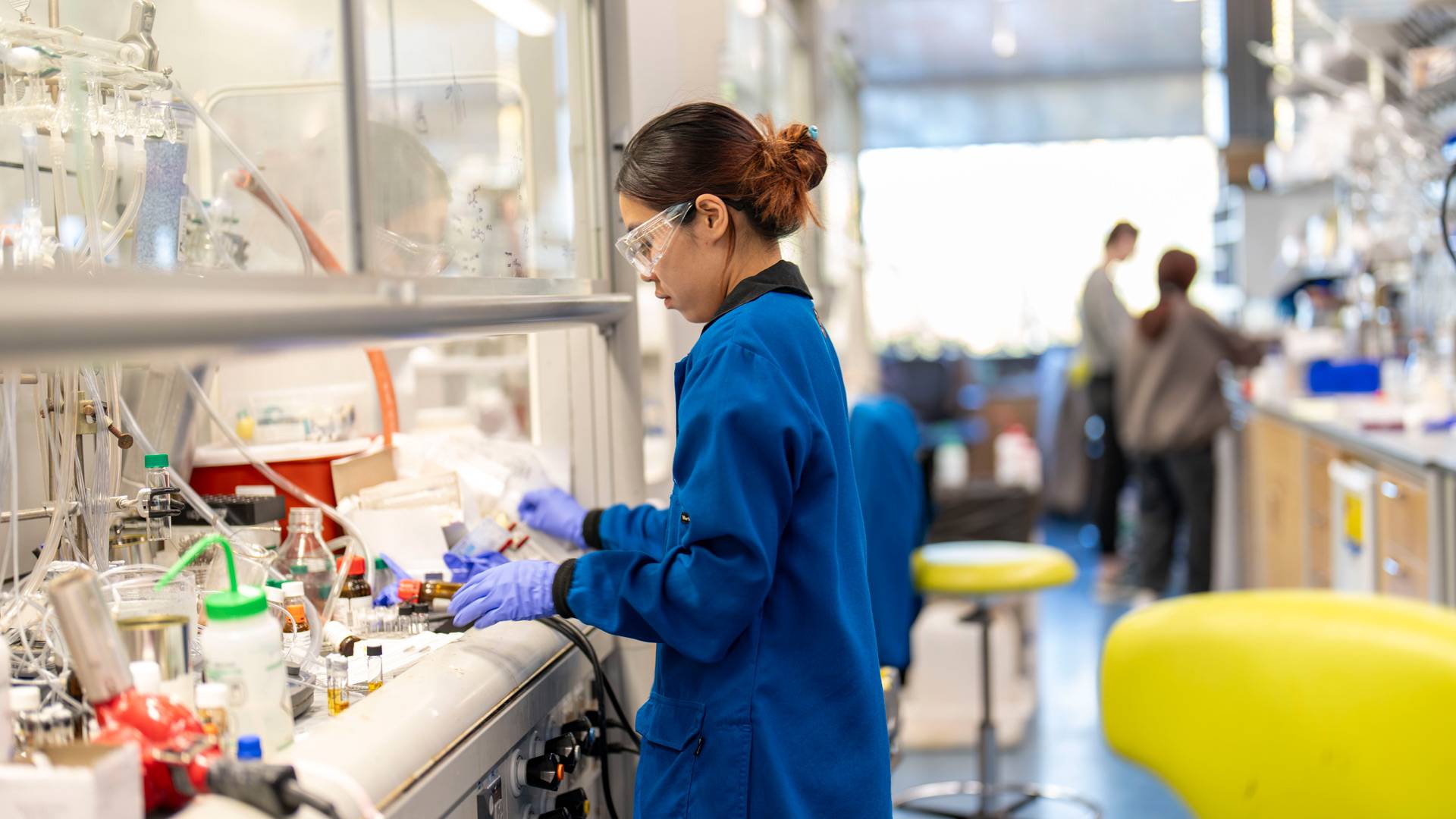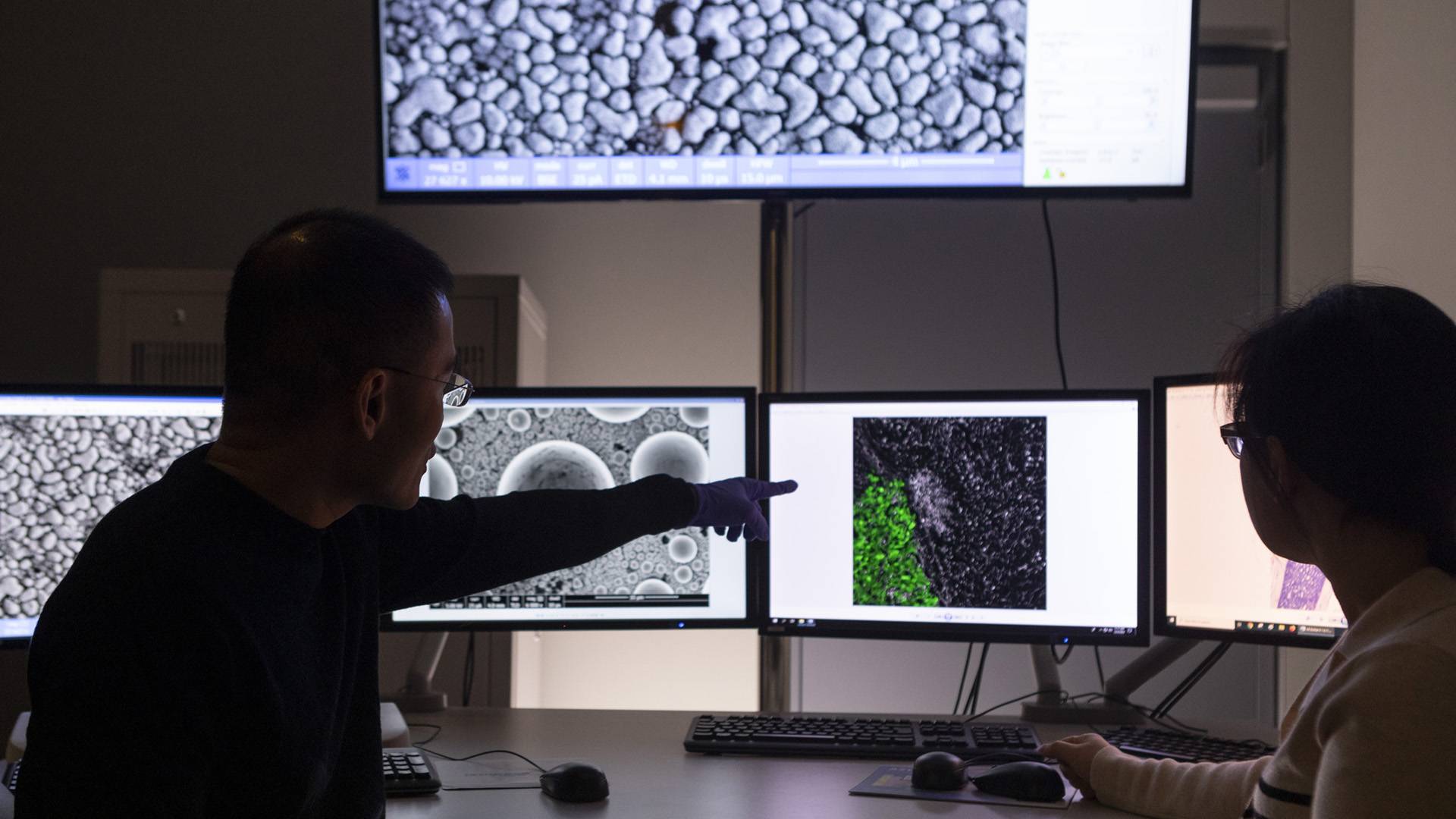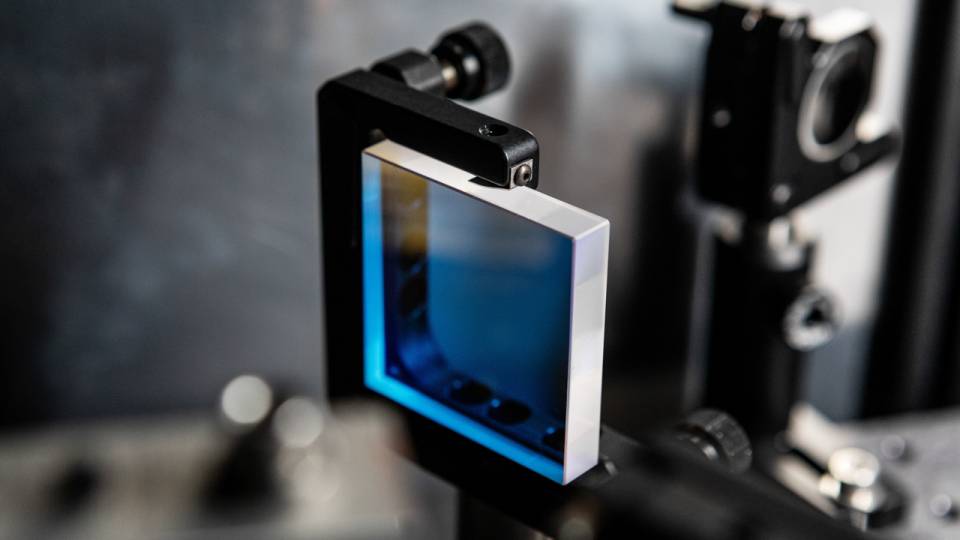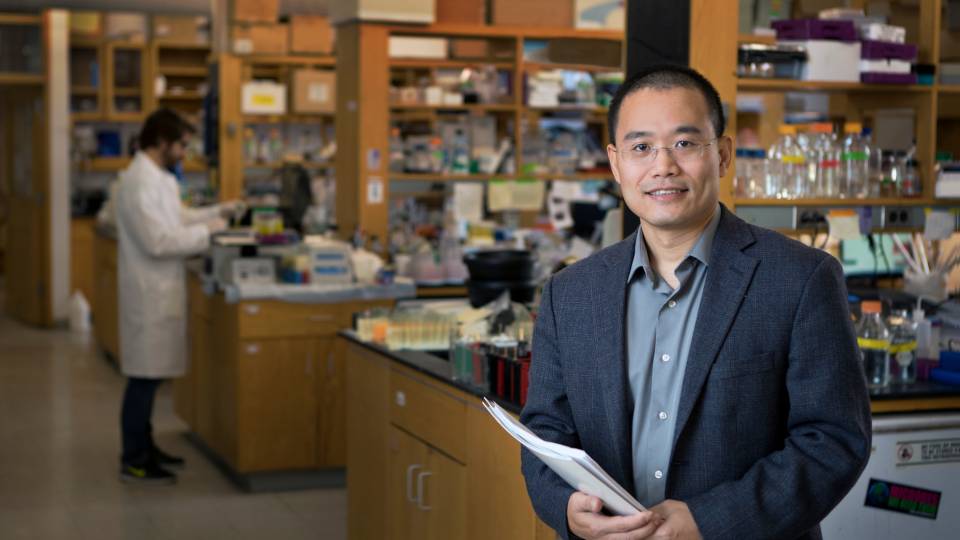Princeton cancer biologist Yibin Kang (left) shows an early-career scientist some very high resolution imaging of cancer cells. Kang said the announced NIH funding cuts threaten the intricately balanced mechanisms of American medical research.
For more than seven decades, Princeton and other leading research universities have played an integral role in building and strengthening America’s research system into the envy of the world — a collaborative effort that advances human health, strengthens national security and gives America a crucial edge in global competitiveness.
The key to that system is a partnership between the federal government and research universities that grew out of make-or-break World War II research efforts like the Manhattan Project. Those projects helped the government recognize the paramount importance of science and scientists to the nation’s success.
This remarkable government-university collaboration has led to an unprecedented pace of invention, innovation and discovery, said Michael Gordin, a renowned historian of science and the dean of the college at Princeton University.
“By any metric, the success of the American research establishment is extraordinary,” said Gordin, who is also Princeton’s Rosengarten Professor of Modern and Contemporary History. “There’s no form of recognition — Nobel Prizes, any other kind of prizes, publications, citations — in which the U.S. is not the world leader. And all of this is based on a deal where the government provides funding, and in exchange it gets products, research, national security, prestige, and the next generation of qualified scientists.”
America’s leadership in technology and medicine rests on that foundation — a foundation now under threat from proposed cuts that would result in billions of dollars less being invested in university research conducted on the government’s behalf.
In medical science, the partnership works like this: The National Institutes of Health asks university researchers to compete for grants in areas of discovery it prioritizes — cancer research, brain science, child development, adolescent mental health, assistive technologies like artificial limbs, healthy aging, and more. Princeton has 199 active NIH grants covering many of these topics, and those grants make up roughly 22% of the University’s research portfolio.
“World-class research institutions like Princeton do the lab work on behalf of the American people in university laboratories with university-trained scientists who are the very best in their fields,” said Peter Schiffer, Princeton’s dean for research. “Those researchers then share their findings publicly, ultimately leading to lifesaving treatments, inventions, technologies and solutions.”
Healthcare in America has been utterly transformed by NIH-supported university discoveries, including these:
- The discovery of GLP-1 drugs to reduce obesity, one of the biggest risk factors for Type 2 diabetes, pioneered by a scientist at Massachusetts General Hospital (part of Harvard Medical School).
- The transformational lung cancer chemotherapy drug Alimta, developed by Princeton chemist Edward C. Taylor in collaboration with Eli Lilly.
- The development at UT Southwestern Medical Center of statins and PCSK9 inhibitors, which lower cholesterol and dramatically reduce heart disease.
- The breakthroughs at MD Anderson Cancer Center (also part of the University of Texas system) in the new field of immunotherapy, which harnesses the immune system to treat a range of cancers that have been intractable in the past.
- The mRNA vaccines pioneered at the University of Pennsylvania that saved millions of lives during the COVID pandemic.
Universities also subsidize government research funding with facilities and faculty paid for by endowments and the generosity of private donors. Additionally, universities pay out of their own pockets to fund research in its earliest stages and too unproven to secure government grants — so-called “blue sky” research, whose practical payoff may be great but far away.
“Indirect costs”: Real, required expenses
The government-university relationship is now at risk. On Feb. 7, in what sounds like a wonky and minor move, an NIH memo announced the agency’s intention to cap the so-called “indirect costs” reimbursed by NIH grants.
In NIH and other federal research grants, direct costs can pay for sophisticated equipment, supplies like petri dishes and chemicals, and salaries for researchers. The essential connective tissues that keep research going — from science libraries to utilities to IT support — are classified as “indirect costs” because their value can’t be directly assigned to any one project: What percentage of the operating costs for a cryo-electron microscope contributes to curing cancer? The NIH pays to partially reimburse universities for these indirect costs because without them, research labs would go dark.
Every university and research institution works closely with the federal government to decide what indirect “rate” will be added to the direct costs. These rates are renegotiated every few years and generally range from 50 to 80 percent of a subset of the direct costs. The proposed NIH cap would cut this rate to 15% for all grant-receiving institutions. Princeton’s reported rate is 64%, but that does not mean 64 cents of every federal dollar go to overhead. In reality, based on the complicated math of grant awards, it’s only 27 cents on the dollar, with the other 73 cents of every federal grant dollar paying for direct costs.

At Princeton, 73 cents of every federal research dollar are spent on the direct costs of research. The other 27 cents on the dollar go to the essential “indirect” costs that support world-class research, including computing equipment and specialized staff.
On Feb. 7, the NIH announced a 15 percent cap on these “indirect” costs at research universities, now under court review. (Existing contracted reimbursement rates range from 50 to 80 percent.) Princeton’s reported rate of 64 percent looks like it means that 64 cents of every federal dollar go toward these “indirect” costs, but because the actual reimbursement rate is a percentage of a percentage and because only 58 percent of direct costs are subject to the indirect rate, 27 cents is the actual figure.
The math works like this: For every $100,000 in federal funding, Princeton currently gets .64 x .58 x $100,000 = $37,000 additional dollars toward “indirect” costs. The final percentage is therefore $37,000 ÷ $137,000 = 27 cents on the dollar.
Indirect costs, the non-obvious but vital components of research, account for more than a quarter of the agency’s contracted support for the nation’s medical research. In 2023, NIH grants supported more than $35 billion in biomedical research nationwide, of which about $9 billion went to indirect costs.
The proposed cap, now under court review, would “harm the quality of medical care in this country, because we will no longer be making the kinds of discoveries that have advanced the quality of health and wellbeing for the last 75 years,” said Shirley Tilghman, the emeritus president of Princeton University and professor of molecular biology and public affairs.
“Direct costs are obvious — consumables, supplies, salaries for people who conduct research — but indirect costs are equally essential,” said cancer biologist Yibin Kang, whose breakthroughs have led to multiple cancer treatments currently working their way to market. “You cannot keep the lab going without both.”
Kang described indirect costs in terms of a pastry shop. “You have to buy flour, buy sugar, pay your employees, and so on. Those are your obvious, direct costs.
“But you cannot make a pie if you don’t have ovens, gas to heat the ovens, lights, running water,” said Kang, who is Princeton’s Warner-Lambert/Parke-Davis Professor of Molecular Biology. “In research, our ‘product’ is discoveries, and some of those discoveries could lead to new medicines for cancer patients. And in universities, another of our products is a trained workforce — the next generation of scientists.”
At risk: “This extraordinary enterprise”
Federal funding has never fully covered the costs of research, so research institutions have always funded the difference. Princeton’s cutting-edge facilities for environmental science and bioengineering, for example, are supported not by federal funds but by private donors and the University endowment.
“This social contract has worked enormously well for the United States, and we mess with this at our peril,” said Tilghman, who advised the government during the Human Genome Project. “This would be the classic self-inflicted wound. If the 15% cap on indirect costs goes into place, it would undermine all of the universities and research institutes that are now producing the kinds of advances that power the American economy and are making the world healthier.
“I’m horrified at the thought that we are going to essentially hobble this extraordinary enterprise that is producing so much good,” she said. “We’re at the cusp of one of the most exciting moments in biomedical science.”

This remarkable government-university collaboration has led to an unprecedented pace of invention, innovation and discovery.
Kang said the prospect of funding cuts threatens the intricately balanced mechanisms of American medical research in a way that will affect American competitiveness for generations.
“Research is not like a faucet you can turn on and off,” he said. “It takes years to build a research enterprise and keep it running smoothly. When you stop clinical trials, when you lose students in training programs, when you stop ongoing experiments that take years to build up, first of all it’s very wasteful, because all those go down the drain. Second, it’s very hard to recover from. Irreversible damage could be done.”
Abrupt funding cuts have “a chilling effect on our trainees,” said Kang. “They’re worried for their current jobs and worried for their future prospects, because many institutions are considering laying off current staff and freezing hiring or recruitment, due to expected resource constraints.
“Graduate students ponder whether they should continue to pursue a Ph.D.,” he said. “We are going to have a generational gap in the professional workforce. That will jeopardize the leadership position of the United States at a time when China, Europe and many others are vying to be the leaders at the frontiers of biomedical research, at a time when AI and many other breakthroughs are energizing the field and accelerating the pace of discovery and translation. We are at risk of losing the lead at the most critical juncture of this competition.”
Gordin said the ramifications extend beyond university campuses to the commercial ecosystem of medical discovery. “I think the strength of America’s research system is the fact that it’s interwoven and porous,” he said. “The capacity to train more students is the most essential part of it, because university graduates then go on to work in universities, in industry and in national labs.”
In the history of modern science, “we only have one example of an industrialized, leading scientific country that starved its scientists, and that was the former Soviet Union,” Gordin noted. “The results were quite catastrophic. In the first decade after the collapse of the Soviet Union, Russia lost 70% of its scientists.
“A small fraction left the country, but most just got other jobs,” he said. “They went into industry, or became advertising executives or sold real estate. That was a lot of human capital that was heavily trained up on the public purse that then dissipated. And it’s very hard to restart a system like that. Russia still hasn’t been able to restart it.”





